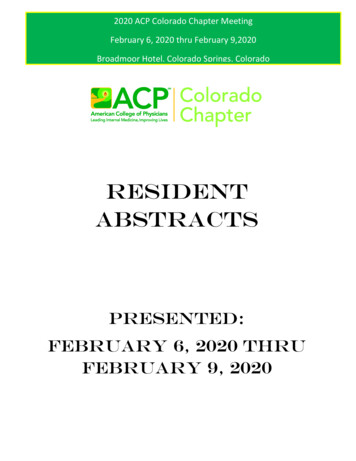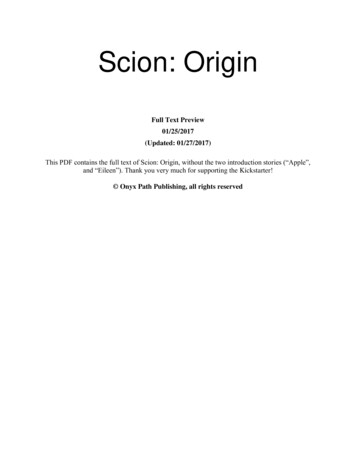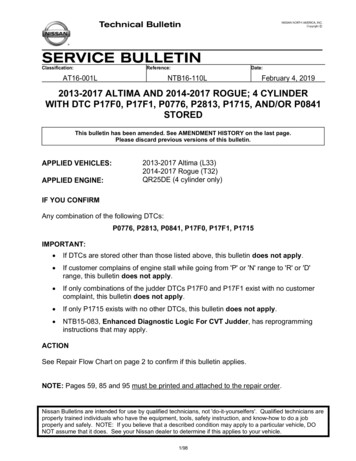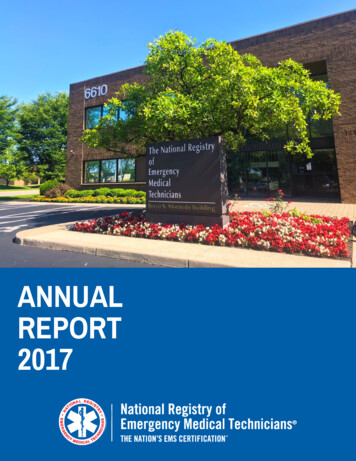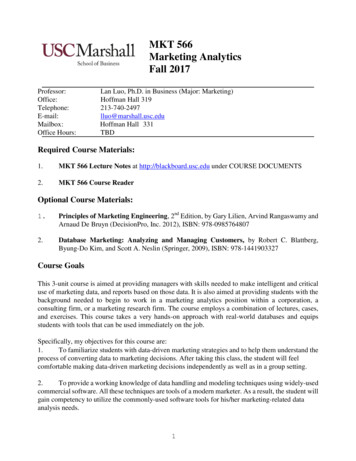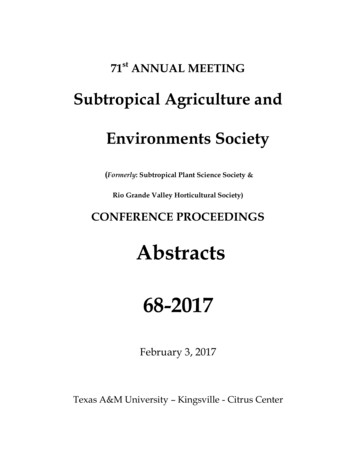
Transcription
71st ANNUAL MEETINGSubtropical Agriculture andEnvironments Society(Formerly: Subtropical Plant Science Society &Rio Grande Valley Horticultural Society)CONFERENCE PROCEEDINGSAbstracts68-2017February 3, 2017Texas A&M University – Kingsville - Citrus Center
Student Abstracts 2017 Poster winnersFirst PlaceToward a better understanding of Asian Citrus Psyllids (Hemiptera: Liviidae) hostselection behaviorG. Sanchez1, 2*, R.R. Saldana1, J.M. Hearn1, Mamoudou Setamou11Texas A&M Kingsville, Citrus Center, Weslaco, TX2Texas State Technical College, Harlingen, TX*Corresponding author: gsanchez36663@mymail.tstc.eduFactors controlling the Asian citrus psyllid (ACP), Diaphorina citri, host finding and selection are poorlyunderstood. Implementation of an effective ACP control requires an understanding of its host selectionprocess. ACP preferentially selects young expanding flush shoots for feeding and its reproduction solelyoccurs on these juvenile shoots. Previous research has shown that young shoots are softer with lightgreen color; had higher volatile organic compounds and contained more free amino acids indicating anutritionally richer diet relative to mature flush shoots. To better understand the host selection behaviorof ACP, young shoots of six known Rutaceae host plants were tested in a multiple choice assay. Flushshoots were inserted in an aquatube containing a hydroponic solution to maintain their turgidity, anddisposed equidistantly on a circular tray for selection by ACP over a 48 h-period. A combination of visualand olfactory cues showed that ACP adults had a preference for grapefruit relative to three other citrusspecies namely sweet orange, lemon and lime, and two non-citrus Rutacae (curry leaf and orangejasmine). In a second trial, ACP adults were released in the desiccator containing four flush shoots ofyellow sapote, a non-psyllid host. After a 24 h-period, similar numbers of grapefruit flush shoots wereintroduced in the arena. A high proportion of ACP adults (ca. 70%) moved from the non-host to suitablehost flush shoots. In contrast, when flush shoots of a suitable host plant were introduced and flush shootsof another suitable host were added, settled ACP adults on first host plant rarely move. Taken together,the data provided valuable insight in ACP behavior while searching for a suitable host.
Second PlaceDiversity of Brevipalpus mites in South Texas from different citrus host plantsA. Fuentes1,2, E. Braswell2, A. Racelis1.Department of Biology. University of Texas Rio Grande Valley, Edinburg, TX.2USDA APHIS CPHST Mission Lab, Edinburg, TX.* Corresponding author: Alejandra.Fuentes@aphis.usda.gov1Mites belonging to the genus Brevipalpus (Tenuipalpideae: Acari) are considered of economic importanceto U.S. agriculture. Besides causing direct feeding damages, Brevipalpus species have been associatedwith the transmission of plant viral diseases, including the Citrus Leprosis Virus (CiLV). Citrus leprosis iscaused by CiLV and is among the most serious diseases of citrus in the world because it can ultimatelykill citrus trees. Even though leprosis has not been reported to be present in the United States, thepotential vectors of this disease, are already established in Texas citrus. The diversity of Brevipalpusmites in South Texas citrus orchards was previously studied using morphology and molecular data.However, some of the species in this genus have been recently re-described. In this study, Brevipalpusmites were collected from different locations in South Texas from four different citrus host plants, andidentified using cytochrome oxidase I sequencing. A total of 216 sequences were obtained. Thephylogenetic analysis confirmed the presence of four Brevipalpus species in South Texas, including, B.californicus, and B. yothersi. The haplotype network analysis revealed the existence of 23 differenthaplotypes. For B. yothersi, 11 haplotypes were recovered, and for B. californicus 9. The most commonhaplotype was HAP03, which was included in the B. californicus haplotype group, and was found in66.20% samples from this study. The second most common haplotype was HAP02, which was identifiedas B. yothersi, and was found in 13.43% samples. Both species were recovered from the four differentcitrus host plants, suggesting that there is no host association of Brevipalpus mites with citrus species.
Third PlaceAmplification of acaricide target site genes in Rhipicephalus (Boophilus) annulatusH. Moreno1, J.P. Tidwell2, G.M. Klafke2, R.J. Miller2, A.A. Perez de Leon31University of Texas Rio Grande Valley, Edinburg, TX2USDA-ARS Cattle Fever Tick Research Laboratory, Edinburg, TX – USA3USDA-ARS Knipling-Bushland U.S. Livestock Insects Research Laboratory; Veterinary Pest GenomicsCenter, Kerrville, TXPesticide resistance is a growing problem around the world with reports of cockroaches, mosquitoes, andticks. The cattle fever tick, Rhipicephalus (Boophilus) annulatus is a tick of veterinary importance beinga vector for Babesia bovis, B. bigemina, and Anaplasma marginale (Rodriguez-Vivas et al., 2014). R.microplus, a closely related species to R. annulatus, has shown resistance to multiple acaricides that targetdifferent neurotransmitters namely, voltage-gated sodium channels, gamma-aminobutyric acid receptors(GABA), and octopamine receptors. Single point mutations have been found in these genes that correlateto acaricide resistance. In this study, we are the first to sequence the target site regions of these genes inR. annulatus. We designed primers to amplify the acaricide target site region of the different genes in 10adult R. annulatus ticks and sent them in for sequencing. We present the results of our research here.
1. Biological control of cattle fever ticks, J. Goolsby, F. Guerrero, J. Kashefi, L, Smith, A. Racelis, D.Amalin, M.J. Flores, N. Abes; K. Verly; N. Singh; P. Azhahianambi, A. Jesudasan, P. DeBarro, A. Sheppard,K. Wyckuys, J. Liu, A. Schwartz, H. Hasel, K. Varner, D. Ellis, & A. Pérez de León2. Cattle fever tick, Rhipicephalus (Boophilus) microplus (Acari: Ixodidae) potentialcontrol on pastures by application of urea fertilizer, B. Leal, D. B. Thomas, R. Dearth3. Araneae as a potential bio control against the Rhipicephalus (Boophilus) microplus(cattle fever tick), Bethany Olivarez4. Lethal time analysis of acaricides in the Cattle Fever Tick, Rhipicephalus microplus,D. Sanchez, D. Rodriguez, J. Tidwell, G. Klafke5. Amplification of acaricide target site genes in Rhipicephalus (Boophilus) annulatus,H. Moreno, J.P. Tidwell, G.M. Klafke, R.J. Miller, A.A. Perez de Leon6. GPS collar performance on ocelot and bobcat in South Texas,T.R. Shirley, M.E. Tewes, J.V. Lombardi, J.P. Leonard, A. Ortega-Sanchez, J.P. Wied, T.A. Campbell7. Evaluation of non-invasive fecal sampling for monitoring bobcats and ocelots in SouthTexas, D.R. Taylor, R.W. DeYoung, M.E. Tewes, T.L. Blankenship, T.A. Campbell38. Effects of rainfall and coyote abundance on spatial distribution of bobcat and ocelot.,M.O. Hewitt, M.E. Tewes, J.V. Lombardi, J.P. Wied, J.P. Leonard, A. Ortega-Sanchez Jr., T.A. Campbell9. Analysis of Activity Patterns of Sympatric Ocelot (Leopardus pardalis) and Bobcat (Lynxrufus) in South Texas Using Cameras, J.P. Wied, M.E. Tewes, J.V. Lombardi, J.P. Leonard, A. Caso,A. Ortega-Sanchez, T.A. Campbell10. Abundance, activity patterns and interactions among ocelots, cattle, nilgai, feral hogsand javelinas, S.B. Carter, M.E. Tewes, J.V. Lombardi, J.P. Wied, J.P. Leonard, A. Ortega-Sanchez, T.A.Campbell11. Change and fragmentation of woody cover in the Lower Rio Grande Valley from 19842016., J.V. Lombardi, M.E. Tewes, H.L. Perotto, Tyler A. Campbell12. Mexican Fruit Fly (Anastrepha ludens) (Loew) Diet Development, Acid ComparisonBioassay, A.R. Arellano, H.E. Conway, E.J. Salinas, C. Vitek13. Comparison of nitrogen sources to improve mass rearing of the arundo scale; abiological control agent of Arundo donax, H. Lopez, J. Goolsby, A. Racelis, A. Vacek
14. Mexican Fruit Fly (Anastrepha ludens) 2016 Trap and Lure Validation, McPhailTrap with Torula Yeast Borax Comparison versus 2-Component Cone Trap Study, K.Piña, H. Conway, E.J. Salinas, C. Vitek15. Second Year Bait Station Validation Test 2016, E. Shah, H. Conway, E.J. Salinas, C. Vitek16. Diagnostic Capacity of SNP Markers to Differentiate Sterile and Wild MediterraneanFruit Flies, V.L. Ortega , T.N. Todd , R.A. Ruiz17. Examining the utility of two diagnostic methods for revealing the introduction pathwayof oriental fruit flies (Bactrocera dorsalis) collected in California, T.N. Terrance and N. Barr18. Invasive Occurrence of the Zoophytophagous Nesidiocoris tenuis (Heteroptera:Miridae) in the Lower Rio Grande Valley, Gabriela Esparza-Díaz, Thiago Marconi, Raúl T.Villanueva, Carlos A. Avila319. Evaluating the Sensitivity of Real-Time Diagnostic Assays for the Detection of the Old WorldBollworm, L. Ledezma and R. Farris20. Biocontrol of the Asian Citrus Psyllid: Tamarixia Wasp, L.E. Torres, J. Dale, T. Feria Arroyo21. Toward a better understanding of Asian Citrus Psyllids (Hemiptera: Liviidae) hostselection behavior, G. Sanchez, R.R. Saldana, J.M. Hearn, Mamoudou Setamou22. Parasitism rates of Tamarixia radiata (Hymenoptera: Eulophidae) to densities of itshost, Diaphorina citri (Hemiptera: Psylloidea), H. Hernandez, D. Flores, C. Vitek23. Texas Psyllid Survey – Zebra Chip Monitoring Program: Comparison of the last twoconsecutive and contrasting years, A. Silva, E. Huerta, I.E. Badillo-Vargas24. Diversity of Brevipalpus mites in South Texas from different citrus host plants, A.Fuentes, E. Braswell, A. Racelis25. Potential phoretic association of Brevipalus Mites with Anastrepha ludens (MFF), K.Zarzosa, A. Fuentes, E. Braswell26. Mitochondrial DNA variation within the ND2-COI tRNA region for the members of theAnastrepha fraterculus group, R. Mier, R. Ruiz-Arce, W.E. Braswell, A. Racelis27. Rhizobacterial diversity of transgenic cotton plants with respect to conventional plants,L. Vital Lopez and A. Mendoza H.28. Effect of Land Use Change on South Texas Chiropterans, Katharine Jones29. Associated metabolites to Brachiaria decumbens for chemical reclaim coal mining soilsapplying Biochar-Amendment, K. Ríos Montes , D. Hoyos Ossa, G. Peñuela, A. Mendoza Herrera
30. Seedling regeneration, growth, and development on site 55, Kassandra I. Gonzalez, AmbroseAnoruo, Shad Nelson, Greta Schuster31. Physiological analysis of Sphingobium yanoikuyae S72: degrading-hydrocarbonsbacteria, E. Sanchez-Lopez, M.R. Mendoza Lopez, M.A. Cruz-Hernández, O. García-Barrada, A. MendozaHerrera132. Isolation and identification of Aeromonas spp. from clinical and environmental samplesin Reynosa, Tamaulipas, A. Sánchez Varela, J.L. Ortega Balleza, J.L. Hernández Mendoza, J.D.C.Quiroz Velásquez, C. Lizarazo Ortega, I.C. Rodríguez Luna.33. Avian Communities in an Urbanizing Region: Abundance Patterns and Effects of LocalHabitat Features, J. Brush and A. Racelis34. Response in varieties of Bacillus safensis cane, in greenhouse conditions, J.G. GarcíaOlivares J. Reyes Hernández, A. Sánchez Varela, J.D.C. Quiroz Velásquez35. A Vision of the Phaseolus seed system in Oaxaca, A. L. Garcia-Narvaez, S.J. Hernandez-Delgado,J.L. Chavez-Servia, N. Mayek-Perez36. Establishing a screening methodology to evaluate genotypes of sugar and energy canefor drought tolerance, S. Elsayed-Farag, N. Solis-Gracia, J. Enciso, J. Da Silva38. Next-Generation Crop Improvement Using Integrative Genomics and BioinformaticsTechnologies, R. Bedre, S. Irigoyen, A. Jacques, K. Mandadi39. Development of recombinase technology to produce consumer friendly transgenicplants, E.K. Bernal Jimenez, E. Louzada, Y.E. Cerino40. Climatic, geographic and physiographic factors that contribute to the distribution oforegano (Lippia spp.) in Mexico, J.D.C. Quiroz Velásquez, M. Reyes Lara, J. G. García Olivares, Á.Salazar Bravo, B.E. Bazán Cruz3, J.L. Hernández Mendoza41. Use of Seaweed to Stimulate Plant Growth, V. Thomas, H. DeYoe, M. Persans42. Screening for Phytophthora nicotianae resistance of different citrus rootstocks and hybrids, S.Chavez, M. Kunta, E. Louzada43. Development of a synthetic lure for monitoring Asian citrus psyllid, Diaphorina citri(Hemiptera: Liviidae) populations., Idwin Casas, Robert Saldaña, Mamoudou Setamou44. Bioassays of entomopathogenic fungi against Melanaphis sacchari, Karla Cruz-Aldaco, Antonio Narro,Gabriela Esparza-Díaz, Raúl T. Villanueva, Richard A. Humber, Sergio Sánchez-Peña
Animal Science1Biological control of cattle fever ticksJ. Goolsby1*, F. Guerrero2, J. Kashefi3, L, Smith3, A. Racelis4, D. Amalin5, M.J. Flores5, N. Abes5;K. Verly5; N. Singh6; P. Azhahianambi7, A. Jesudasan8, P. DeBarro9, A. Sheppard9, K. Wyckuys10,J. Liu11, A. Schwartz12, H. Hasel13, K. Varner13, D. Ellis14, & A. Pérez de León21United States Dept. of Agriculture, Agricultural Research Service, Knipling Bushland U.S. LivestockInsect Pest Research Laboratory, Cattle Fever Tick Unit, Edinburg, TX; 2USDA-ARS Knipling BushlandU.S. Livestock Insect Pest Research Laboratory, Veterinary Pest Genomics Center, Kerrville, TX;3USDA-ARS European Biological Control Laboratory, Montpelier, France; 4Univ. of Texas, Rio GrandeValley;5De La Salle University, Manila, Philippines; 6Dept. of Veterinary Parasitology, Guru Angad, DevVeterinary and Animal Sciences Univ., Punjab, India; 7Dept. of Veterinary Parasitology, MadrasVeterinary College, TANUVAS, Chennai, India; 8Madras Christian College, Chennai, India; 9CSIROHealth & Biosecurity, Brisbane & Canberra, Australia; 10International Center for Tropical Agriculture,Hanoi, Vietnam; 11Hebei Normal University, Shijiazhuang, Hebei, P.R. China; 12Texas Animal HealthCommission, Austin, TX; 13USDA-APHIS, Cattle Fever Tick Eradication Program, Laredo, TX;14Institute for Infectious Animal Diseases, Department of Homeland Security, Science and TechnologyCenter of Excellence, Texas A&M University System, College Station, TX*
2 Texas State Technical College, Harlingen, TX *Corresponding author: gsanchez36663@mymail.tstc.edu Factors controlling the Asian citrus psyllid (ACP), Diaphorina citri, host finding and selection are poorly understood. Implementation of an effective ACP control requires an understanding of its host selection process. ACP preferentially selects young expanding flush shoots


